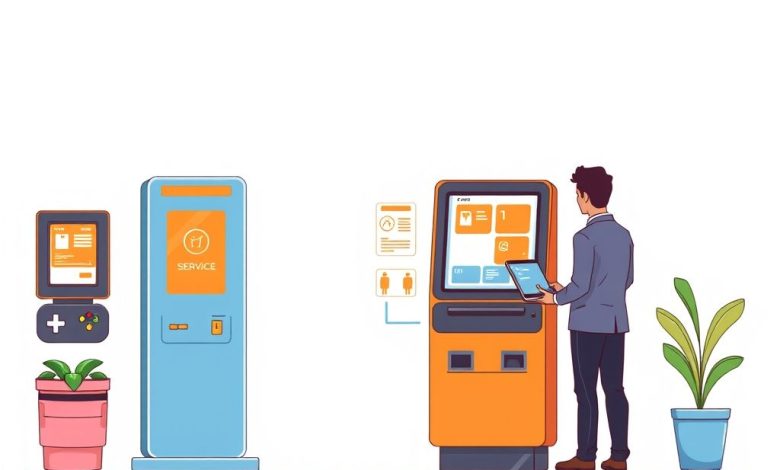Field Service Management for Kiosk ATM Maintenance

Introduction
Field Service Management (FSM) has become increasingly crucial in modern business operations, particularly for industries dealing with kiosks and ATMs. These self-service devices require regular maintenance to ensure optimal functionality and customer satisfaction. Effective FSM strategies have transformed how companies manage their field technicians, streamline processes, and improve overall efficiency.
- The Rise of Self-Service Technology
- Implementing Field Service Management for Kiosk and ATM Maintenance
- Asset Tracking and Management
- Scheduling and Dispatch Optimization
- Remote Monitoring and Diagnostics
- Technician Training and Certification
- Case Study: Successful Implementation of FSM in Kiosk Maintenance
- Conclusion
The Rise of Self-Service Technology
Kiosks and ATMs have revolutionized the way businesses interact with customers and provide services. These automated devices offer convenience, speed, and cost-effectiveness compared to traditional human interaction. However, their reliance on technology also introduces potential points of failure, necessitating robust maintenance schedules.
Key Challenges in Kiosk and ATM Maintenance
- Accessibility: Many kiosks and ATMs are located in remote areas, making it challenging for technicians to reach them quickly.
- Downtime: When a kiosk or ATM fails, it directly impacts customer experience and business revenue.
- Technical Complexity: Modern kiosks and ATMs often incorporate advanced technologies like touchscreens, card readers, and network connectivity, requiring specialized knowledge to maintain.
- Security Concerns: ATMs, in particular, are targets for vandalism and cyber attacks, necessitating secure maintenance procedures.
Implementing Field Service Management for Kiosk and ATM Maintenance
To address the unique challenges of maintaining kiosks and ATMs, organizations must implement a comprehensive FSM strategy. This approach involves several key components:
Asset Tracking and Management
Implementing robust asset tracking systems is crucial for FSM. This allows technicians to locate devices quickly and efficiently manage their schedules.
• Utilize GPS-enabled tracking devices for real-time location monitoring
• Implement cloud-based asset management software for centralized control
• Assign unique identifiers to each kiosk or ATM for easy reference
Scheduling and Dispatch Optimization
Efficient scheduling is critical in FSM to minimize downtime and reduce costs.
• Develop algorithms that optimize route planning based on device locations and technician availability
• Implement mobile apps for technicians to receive real-time job assignments and updates
• Use AI-powered predictive analytics to forecast maintenance needs and schedule preemptive repairs
Remote Monitoring and Diagnostics
Remote monitoring capabilities enable early detection of issues and proactive maintenance.
• Integrate IoT sensors into kiosks and ATMs to monitor vital signs and performance metrics
• Implement remote diagnostic tools allowing technicians to troubleshoot issues without physical presence
• Set up automated alerts for critical failures or anomalies detected through monitoring systems
Technician Training and Certification
Skilled technicians are essential for effective FSM. Organizations should invest in comprehensive training programs.
• Develop specialized training modules focusing on kiosk and ATM technology
• Establish certification programs for technicians demonstrating expertise in these areas
• Provide ongoing training and professional development opportunities to keep technicians updated with latest technologies
Case Study: Successful Implementation of FSM in Kiosk Maintenance
Company XYZ, a leading provider of self-service kiosks, implemented a robust FSM solution to improve their maintenance operations. The results were significant:
• Reduced average response time from 48 hours to 6 hours
• Decreased maintenance costs by 25% through optimized scheduling
• Improved first-time fix rate from 70% to 85%
• Enhanced customer satisfaction scores by 15%
The success was attributed to the combination of advanced asset tracking, intelligent scheduling algorithms, and real-time remote monitoring capabilities.
Conclusion
Field Service Management has emerged as a critical component in maintaining kiosks and ATMs. By implementing cutting-edge technologies and strategies, organizations can ensure optimal device performance, minimize downtime, and deliver exceptional customer experiences. As the self-service landscape continues to evolve, FSM will play an increasingly important role in supporting these technologies and driving business success.
By investing in FSM solutions tailored to kiosk and ATM maintenance, companies can transform their field service operations, improving efficiency, reducing costs, and ultimately enhancing customer satisfaction in this rapidly evolving sector.




